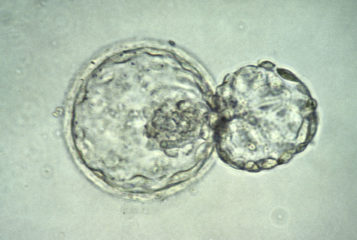Scientists have reportedly created an embryo model from human stem cells with a heartbeat and traces of blood; features that typically appear in an embryo proper during the third or fourth week of pregnancy.
Stem-cell-based embryo models (SCBEMs) can be created without the need for eggs or sperm, resulting in entities or materials that – in some respects – resemble embryos in the earliest stages of human development (see BioNews 1194). The human SCBEM created in this research was specifically designed as a 'non-integrated' SCBEM, meaning that it could not form the extra-embryonic tissues (placenta and yolk sac) that are essential for an embryo to develop during pregnancy.
Dr Jitesh Neupane, from the University of Cambridge, described the research at the International Society for Stem Cell Research's annual meeting in Boston, Massachusetts. He has been clear that his team was not seeking the full replication of human embryos proper. 'I'd like to emphasise that these are neither embryos nor are we trying to make embryos actually,' Dr Neupane explained to the Guardian. 'They are just models that could be used to look into specific aspects of human development.'
Dr Neupane and his team cultivated embryonic stem cells in vitro and transferred them into a rotating bottle, which simulated the environment of an artificial uterus. The resulting SCBEM reportedly replicated beating heart cells and traces of red blood.
'The sophistication of the SCBEMs that can now be created is testament to the talent of the researchers working in this area. For all this sophistication, however, we must remember that these models are not actual human embryos. They mimic certain aspects of embryos to a remarkable degree, making them very useful in research, but there remain profound biological differences from human embryos proper,' said Sarah Norcross, director of the Progress Educational Trust. 'Similarly, the image that will be conjured in most people's imaginations by the idea of a beating heart is very different to the primitive structures and processes that can be found in these tiny models.'
SCBEMs offer scientists the opportunity to study the first few weeks of human pregnancy; in particular, to help understand the impact of genetic disorders and the causes of recurrent miscarriage. However, the results from Dr Neupane's research are yet to be peer-reviewed and have not been published as a journal article or even as a preprint.
'This is another fascinating scientific report that does require further scrutiny. It will be important that this, like the many other exciting recent studies in this area, goes through proper scientific review. However, the UK research community has for some time been actively working on a framework called G-SCBEM to provide public reassurance and scientific rigour to research using stem-cell-based embryo models,' said Professor Roger Sturmey from Hull York Medical School.
Professor Sturmey chairs the Guidelines Working Group of the Governance of SCBEMs (G-SCBEM) project.




Leave a Reply
You must be logged in to post a comment.